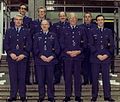With the establishment of the Royal Air Force as an independent service on 1 April 1918, orders were issued detailing new uniform patterns. Major General Mark Kerr designed the first officer uniform which was largely pale blue with gold braid trimmings. [5] [6] Additionally, the Royal Flying Corps' use of khaki was continued. It has been suggested that the pale blue colour was adopted as the cloth had been intended for use by the Imperial Russian Cavalry and, following their disbandment after the Bolshevik Revolution it became available at low cost. As it was the responsibility of officers to buy their own uniforms, a wearing-out period for old uniforms was allowed and the change-over to the air force uniform was slow.
The 'wearing out' period also applied to other ranks. Former members of the Royal Flying Corps and the Royal Naval Air Service continued to wear their old uniforms. New recruits into the newly formed Royal Air Force were often issued with the dark khaki Army Pattern General Service Tunic. Later in 1918 a belted khaki uniform was adopted for other ranks, and it was these tunics that first carried the RAF eagle badges on each shoulder.
The pale blue colour for officers' uniforms was unpopular and impractical [5] and John Slessor who was later promoted to Marshal of the RAF described it as "a nasty pale blue with a lot of gold over it, which brought irresistibly to mind a vision of the gentlemen who stands outside the cinema". [7] A little over a year after its introduction, the pale blue colour was discontinued. On 15 September 1919, Air Ministry Order 1049 replaced it with the blue-grey colour which has remained in use to this day. The khaki uniform continued to be worn until 1924 when it too was replaced by a blue-grey colour.
Later changes in service dress
Air force rumour later had it that the "air force blue" colour of the postwar uniform had been that of a textile produced in quantity to clothe Russian soldiers during the First World War, and not yet exported when the Russian revolution of 1917 closed that market.
A visible distinction between the RAF and the other military services was that all ranks wore a starched collar and tie. Up to 1918, only Officers of the British Army and Royal Navy wore neck-ties; and Officers of all services bought their uniforms from military tailors, while other servicemen were issued clothing from government stocks. Several features of the RAF uniform distinguished officers from airmen; their cap badges were different, airmen's being all brass while officers' were gold-embroidered fabric; airmen wore the RAF eagle patch on both shoulders while officers did not; and the fabric of airmen's wool uniforms was thick and heavy, while officers' uniforms were of "smooth blue" barathea fabric. Another distinction was that while the British Army shod its men only in ankle-high boots the RAF after 1945 also issued its airmen with ordinary shoes for everyday working wear. The shoes maintained the class distinction in that only officers wore shoes with toecaps. Similarly, officers wore unlined brown leather gloves while airmen's gloves were of knitted wool.
"Smooth blue" uniforms for non-commissioned personnel were introduced in the 1950s, first for Warrant Officers. By 1956 NCOs of all ranks (corporal and up) were permitted to buy "smooth blue" uniforms at their own expense. Another innovation of the period was raincoats, hitherto worn only by officers. Despite the rainy British climate, the only weather protection for airmen outdoors was either their heavy winter overcoats or the rectangular ground sheets issued for all soldiers' use on campaign. Regulations were altered in the 1950s to allow airmen to wear raincoats bought at their own expense.
During 1975/6 the wartime "Hairy Mary" working dress uniforms were replaced for all ranks with the 1971 pattern No 2 uniforms. Made of a smooth woollen and man-made fibre mix material the jacket was a loose blouson design with a front zip fastener and epaulettes, often referred to as a 'Thunderbird jacket'. In the mid-1980s RAF blue crew-necked woollen pullovers were replaced with a new V-neck design featuring blue-grey cloth elbow and shoulder patches plus a pen holder patch on the left sleeve. The Thunderbird Jacket was withdrawn in the 1990s and replaced with an additional pullover, the design reverting to a round neck but retaining the pen holder, the official description being Jersey Man's (Woman's) Blue Grey Round Neck.
In the 1990s an RAF blue nylon foul weather jacket and overtrousers were issued. Although not initially intended it quickly became standard practice for officers and other ranks to attach rank badges to the lapels and wear the nylon jacket in place of the uniform raincoat, as a more practical modern wear.





























































